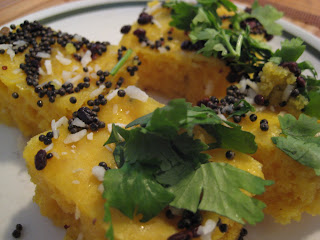
I stopped by the Cookbook Store here in Toronto, and found this section of used cookbooks that I'd never seen before (it's right opposite the cash register). It was by looking through this section that I bought my very first cookery book.
As you can see by the picture, it's by Madhur Jaffrey, a well-known Indian food chef. It was published in 1982; I bought it for $10.00, and it was in mint condition. Ah, cookery books. According to the Merriam Webster Online, the term "cookery book" is chiefly a British term, and dates back to 1639. The word "cookery" dates back to the 14th century and is "the art or practice of cooking". Nowadays, we have a plethora of cookbooks on the market, and this got me thinking about the difference between the two, or maybe a dichotomy that can be found in food culture today.
Cookbooks are often written by celebrity chefs. They sometimes have witty exclamations and catch phrases, to brand their recipes, their cookbook, and their cable tv show. For example, they might yell something like "Boom!" every time they toss seasoning into a pan. Or they might call extra virgin olive oil "evoo". Did that really need an acronym? Who doesn't like saying extra virgin olive oil. It's practically an onomatopoeia.
Cookery books, on the other hand, have been passed down by your mamma or auntie. They might be written in Italian or Armenian or Punjabi, and you will have the darndest time figuring out what the recipes say. Cookery books call for butter. Lots of butter. And cream. And yes, cookery books will put you on Lipitor if you're not careful.
One thing I've noticed about cookbook authors recently, is that a core group of them are getting hotter and hotter. Now, I must say, Jaffrey has quite a striking picture on the back of the cookery book I bought, but do you ever get the feeling that some cookbook authors are Calvin Klein models in their spare time? And yes, I'm looking the way of a certain chef from the Mediterranean. Sure the food looks good, but who can concentrate with all those winning smiles and all that tanned skin?
Cookery books might require you to buy a kitchen scale. It might require you to do things you've never done before, maybe push your skills as a chef. Cookbooks sell a lifestyle. People who buy a Jaime Oliver book often want to be the type of people who buy Jaime Oliver books.
So far, my adventures with Jaffrey have gone quite well. I made a lemony, coriandery chicken dish that had a curry that was heaven. And she does interesting things with raitas (yoghurt salads). Her trick is to beat the yoghurt with a fork so it's smooth and silky.
If you're searching for cookery books you might raid family's bookshelves (if they'll let you), or go here.


